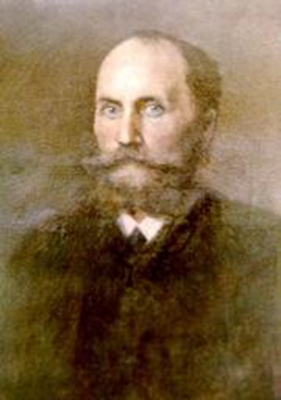Hans Driesch and synchronicity
Hans Driesch (1867-1941) was both a philosopher and a scientist. In fact, he started
as a biologist and only later became a philosopher.
 In his autobiography,
Driesch mentions the year 1898 as a major turning point in his life. Not only
did he definitively convert from materialism to vitalism; he also met his wife,
Margarethe Reifferscheidt. This coincidence, which regards two key moments
(public and private life), already has some significance in itself. As his
autobiography shows, private life and scientific research were insolubly
linked. Driesch became a major supporter of biological vitalism by addressing
and proposing solutions for the conundrum of morphogenesis. Beyond his
scientific successes, his marital life was happy, and his wife accompanied him
on his many travels.
In his autobiography,
Driesch mentions the year 1898 as a major turning point in his life. Not only
did he definitively convert from materialism to vitalism; he also met his wife,
Margarethe Reifferscheidt. This coincidence, which regards two key moments
(public and private life), already has some significance in itself. As his
autobiography shows, private life and scientific research were insolubly
linked. Driesch became a major supporter of biological vitalism by addressing
and proposing solutions for the conundrum of morphogenesis. Beyond his
scientific successes, his marital life was happy, and his wife accompanied him
on his many travels.
Interestingly,
there also seems to be another link between the private and the public (apart
from their personal impact).
After having described how in 1899 he
married in Naples, Driesch adds that he and his wife did not immediately agree
on where they would live. They would at least stay for the winter in Naples.
Naples was also the place where Driesch did his research with sea urchin
embryo’s and where he started accounting for a non-material, unifying
and life-making principle (‘entelechy’). Almost immediately after having
mentioned their wedding and postponed settlement (über den Ort, wo meine Frau und ich uns
niederlassen würden, waren wir uns noch nicht einig) [1], Driesch describes how a discovery by his
friend and colleague, Curt Herbst, enabled him to conduct his experiments with
embryos more successfully. Growing blastomeres requires calcareous seawater (normales Seewasser) to preserve them (ihre Teilungsprodukte blieben von da an
beisammen). Non-calcareous
water will lead to premature termination of cell division (bei Fehlen des Calciums die Furchungszellen
des Keimes nicht beieinander bleiben, sondern auseinander fallen, sodass es
garnicht zur Bildung eines ‘Individuums’ kommt). Therefore, it can be used for researching the
potencies of cells in their successive stages. (Driesch, 1951, p. 113)
It
should be noted that, during their honeymoon weeks, Driesch and his wife stayed
in Cadenabbia, Beatenberg and on the Grosse Scheidegg (sic).[2] “Aber eine in sich
abgeschlossene ‘Hochzeitsreise’ war das natürlich schon alles aus dem Grunde
nicht, weil wir einen festen Wohnsitz ja noch garnicht in näherer Aussicht
hatten.” (Driesch, 1951,
p. 112) The calcareous mountainous regions of Switzerland, however, kept the
itinerant young couple together until it finally settled in Heidelberg, where
there son Kurt (named after Curt Herbst) was born.[3]
Toward the end
of his autobiography, Driesch largely credits his repeated travels and relaxing
strolls – rather than conscious laboratory work itself – for receiving flashes
of insight and renewing ideas: “die ‘Einfälle’ wurden mir gegeben. Sie
stammten aus meiner seelischen Anlage”. (Driesch, 1951, p. 2950 What is a prerequisite, however, is “an
unconditional devotion to an idea” (bloßen
Hingegebensein an eine Idee). (Driesch, 1951, p. 304)[4] Driesch also explicitly admits that he is
not insensitive to life coincidences, such as for example the remarkable role
of the number 9 in his life data. (ib., p. 294)
[1] Hans Driesch (1951). Lebenserinnerungen. Aufzeichnungen eines Forschers
und Denkers in entscheidender Zeit. München/Basel: Ernst Reinhardt Verlag,
p. 112.
[2] scheiden = splitting; Egg/egg. NB: what to think of Driesch’ wife’s name:
Reifferscheidt? (Reife = ‘maturity’; scheidt = ‘split’); or even
the adjective used in the autobiography (in entscheidender Zeit).
[3] “Die Geburt unseres Sohnes machte uns natürlich etwas sesshafter”.
Driesch, 1951, p. 129.
[4] “Man übergibt gleichsam – das freilich muss man in bewusster Weise – einem
‚anderen‘ den Auftrag zur Arbeit und dieser ‚andere‘, heiße er Seele,
Unterbewusstsein oder wie sonst, arbeitet dann.” Driesch, 1951, p. 304. Similar to Driesch, Henri Poincaré mentions the inexplicable
concomitance of his discoveries with periods of apparent inactivity of consciousness.
Poincaré, 1920, p. 50f. His entire Science et méthode is dedicated to
the ‘(il)logic’ of discovery.



Reacties
Een reactie posten